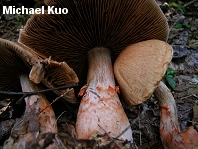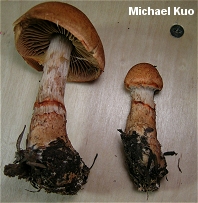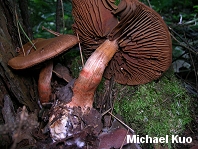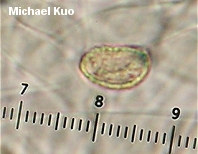| Major Groups > Gilled Mushrooms > Dark-Spored > Cortinarius > Cortinarius armillatus |

|
Cortinarius armillatus [Basidiomycetes > Agaricales > Cortinariaceae > Cortinarius ... ] by Michael Kuo This impressive Cortinarius is mycorrhizal with birch, and is a common late summer and fall mushroom in northern forests where birch appears. Its stem has a swollen base, its dry cap is yellow-brown to reddish brown, and its gills are dirty yellowish to pale cinnamon before maturity. The most distinctive feature of Cortinarius armillatus, however, is the series of two to four bright, orange-red "bracelets" encircling the stem. A recent investigation of about 1,000 armillatus-like specimens from northern Europe (Niskanen and collaborators, 2011) found support for six separate species, three of which are known to occur in North America: Cortinarius armillatus, Cortinarius luteo-ornatus, and Cortinarius paragaudis. Among these, Cortinarius armillatus is distinct by virtue of its bright orange-red (as opposed to pinkish or wine red) bracelets; its comparatively long, ellipsoid, thick-walled spores; and its exclusive association with birch, rather than conifers. That last item, however, can be very tricky to assess in northern forests, which are often "mixed." Description: Ecology: Mycorrhizal with birch; growing alone, scattered, or gregariously; summer and fall; widely distributed in northern North America. Cap: 5-15 cm; convex or bell-shaped, becoming broadly convex, broadly bell-shaped, or nearly flat; dry; bald, finely hairy, or very finely scaly over the center at maturity; yellow-brown to reddish brown, often with a deeper, brick red center; sometimes fading to dull tan. Gills: Attached to the stem; close or nearly distant; pale dirty yellowish to pale cinnamon at first, becoming rusty brown with maturity; covered by a whitish cortina when young. Stem: 7-15 cm long; up to 2.5 cm thick; swollen at the base; dry; bald or finely silky; whitish to pale brownish; encircled by 2-4 orange-red, concentric bands; with a rusty ring zone above the bands; basal mycelium whitish. Flesh: Whitish to pale brownish. Odor: Not distinctive, or radishlike. Chemical Reactions: KOH on black on cap surface; purple on orange areas of the stem. Spore Print: Rusty brown. Microscopic Features: Spores 9-12 x 5-7 µ; ellipsoid; finely warty; moderately to strongly dextrinoid; with thick (about .75 µ) walls. Cheilo- and pleurocystidia absent. Pileipellis a cutis. REFERENCES: Fries, 1838. (Fries, 1818; Fries, 1821; Saccardo, 1887; Kauffman, 1918; Kauffman, 1932; Smith, 1975; Smith, Smith & Weber, 1979; Arora, 1986; Phillips, 1991/2005; Lincoff, 1992; Barron, 1999; Roody, 2003; McNeil, 2006; Miller & Miller, 2006; Niskanen et al., 2011.) Herb. Kuo 09039503, 09110507. This site contains no information about the edibility or toxicity of mushrooms. |
© MushroomExpert.Com |
|
Cite this page as: Kuo, M. (2011, December). Cortinarius armillatus. Retrieved from the MushroomExpert.Com Web site: http://www.mushroomexpert.com/cortinarius_armillatus.html |



